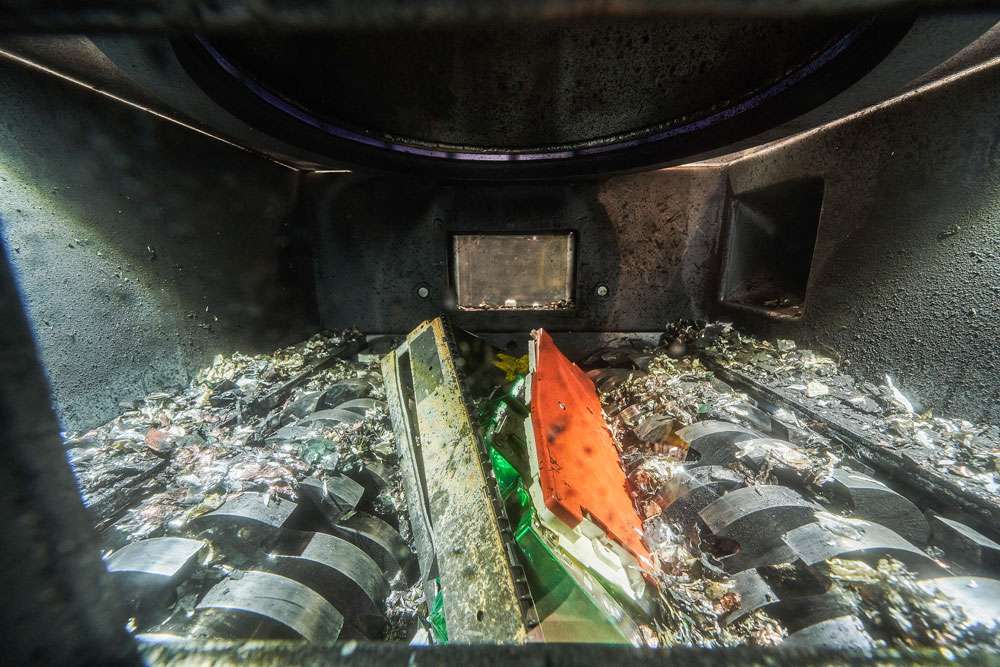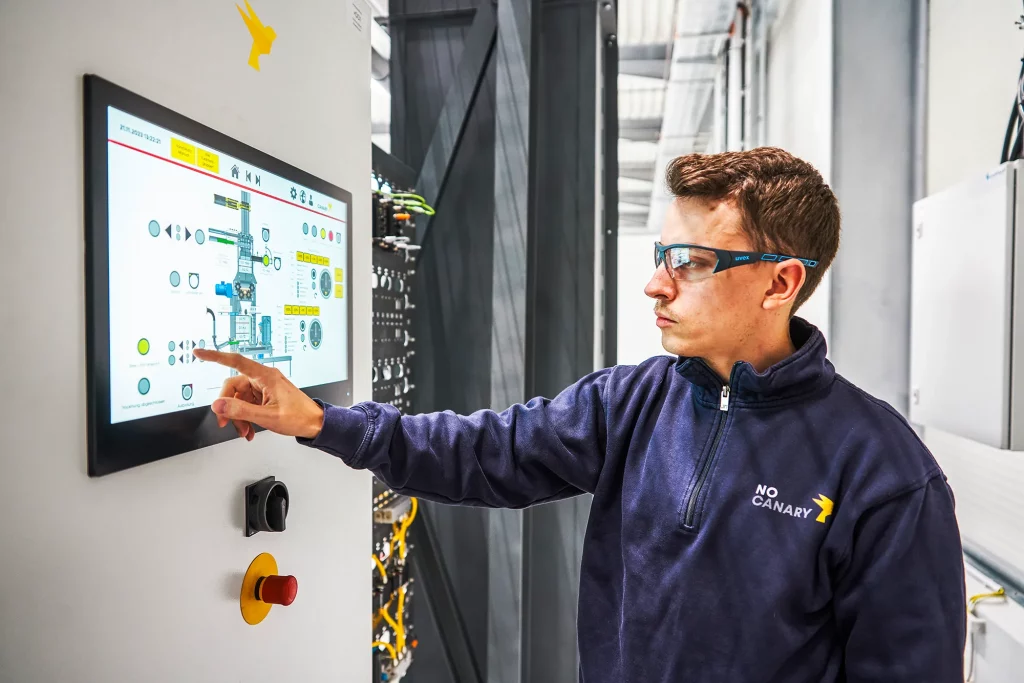Vacuum shredding
In the vacuum shredding process step, we rely on a technology that is unique worldwide: we shred lithium-ion batteries in a vacuum environment. No Canary offers a safe and efficient shredding solution that forms the heart of our battery recycling plants. This process – shredding batteries at extremely low pressure – is a key component in achieving high throughput and maximum safety. The batteries are mechanically broken up in a vacuum environment that is protected against explosions and simultaneously vacuum-dried, which represents a technological leap forward compared to conventional shredders. Last but not least, this shredder is designed to be completely gas-tight. With vacuum shredding, we offer an innovative plant component that significantly defines the performance and safety of our recycling lines.
With our vacuum shredding, recyclers and OEMs receive a turnkey vacuum shredder module that has been specially designed for lithium-ion batteries and other materials that should not contaminate the environment.
- robust industrial shredder housed in a gas-tight enclosure
- batteries or modules are fed into the chamber via a lock system without ambient air entering
- during operation, vacuum pumps generate a pressure of up to 5 mbar absolute in the shredding chamber
- precise control of the vacuum and temperature during shredding to optimize conditions
- batteries are cut/broken up, while the liquid electrolyte evaporates at the same time
- including all necessary components: vacuum pumps, condensation/filter unit for the vapors produced, sensors for pressure and gas monitoring, and explosion protection control
In short, we offer a complete vacuum shredder as a modular component of the recycling plant, which fits seamlessly into the overall process and is linked to pre- and post-processing.
The low pressure significantly reduces the boiling point of the electrolyte solvent, causing a large proportion of the liquids to evaporate instantly. The heat generated during shredding also causes the electrolyte to boil off – the shredding energy is therefore used synergistically for drying. Our vacuum pulverizer is designed to be pressure shock resistant in accordance with ATEX and is equipped with sensors that detect pressure peaks. Explosion protection is provided intrinsically by the vacuum. During the process, the material remains in constant contact with a rotating shaft/mixing tool, resulting in intensive mechanical mixing – this supports the abrasion of the active materials from the foils. The entire system is designed so that no oxygen enters the process and any gases produced (solvent vapor) are immediately extracted and condensed. Vacuum comminution can be operated in direct conjunction with our intensive drying process – in fact, both take place in a single step. Overall, we offer a highly advanced comminution apparatus that integrates mechanical comminution, inerting, and drying in a single step.

The introduction of vacuum shredding into battery recycling was a logical step for us to solve several problems associated with conventional processes. Conventional shredding processes usually operate under inert gas (nitrogen). The vacuum allows us to achieve the necessary safety without consuming vast amounts of protective gas, and we can combine drying and shredding, which saves time and energy. Our motivation was to make recycling more efficient and safer—vacuum shredding is the key to this. We developed vacuum shredding to give our customers a safety advantage and efficiency gains in the recycling process that were not achievable with conventional technology.
Depending on the design, our vacuum shredding modules can process several hundred to two thousand kilograms of batteries per hour. Typical key figures are:
Single cells, modules, packs
Battery input formats
5 mbar
Vacuum level
Freely scalable
Shredder drive power
Approx.
5–20 mm
Heavy Parts
<0.5 mm
Particle size output (Black Mass)
> 90 %
of the solvents evaporate and condense (typical)
* Reference measurement with Panasonic NCA 21700 (TESLA Model 3) after drying for 30 min at 40°C with No Canary Technology.
< 1 %
Residual moisture of the output (typically ~0.5%)
Vacuum shredding gives us a decisive advantage over competing processes: greater safety with less effort. Competitors who shred batteries usually do so in a nitrogen atmosphere or with complex extinguishing and cooling systems to prevent explosions. This results in high running costs and complex technology. Our solution, on the other hand, falls below the required explosion protection level by a factor of twenty through the vacuum alone – not many conventional systems achieve such a safety margin ( ). At the same time, we save on expensive measures such as continuous flooding with N₂ or CO₂, which keeps our operating costs much lower. Another advantage is process-integrated drying: others have to dry the material after shredding (e.g., in drying cabinets) before it can be further processed. With us, this happens in the same step, which means that the throughput is significantly higher. We also have advantages in terms of the environment: We capture organic vapors immediately and condense >99% of them instead of burning them in an exhaust flare or binding them in activated carbon. This makes the process cleaner and often less harmful in terms of approvals (fewer emissions). In addition, the elimination of inert gas also means fewer indirect emissions (N₂ must be produced in an energy-intensive process).

What is special about our vacuum comminution is that we combine several normally separate processes in a single step – a real novelty. Our core expertise (and unique selling point) is our mastery of comminution in extreme vacuum. Mechanical grinding is nothing new in itself, but working in the pressure range of a few mbar under industrial throughput conditions is unique. Added to this is functional integration: grinding, drying, and solvent recovery take place simultaneously in one apparatus. This integration requires a deep understanding of both the mechanical processes (grinding, mixing) and the thermal dynamics in a vacuum – No Canary has developed its own models and test data for this purpose. The plant design itself is also special: a vacuum-tight, explosion-proof shredder chamber with a sluice system is unprecedented in this form and testifies to our engineering expertise. Another unique feature is that we achieve a side effect with the vacuum technology, namely that we manage the fire risk without additional oxygen sensors or extinguishing agents – safety through physics, you might say, instead of complex measurement technology. This principle is simpler and more reliable, which makes our system particularly robust in difficult environments (e.g., if sensors fail, the vacuum remains in place as a safety measure). In summary, the special feature of No Canary vacuum shredding is its innovative character: no one else has this combination of capabilities, and it is a central component of our unique selling point in the market.
Our vacuum shredding significantly increases the overall performance of the recycling process
- Combining shredding and drying in a single step drastically reduces processing time – throughput increases significantly as no separate drying phases are necessary
- The technical design (powerful motors, robust gearbox) ensures that even larger battery modules can be processed directly without pre-shredding – a performance bonus, as less preparatory work (manual opening, etc.) is required.
- Finally, high performance also means stability under full load: our vacuum system maintains a constant vacuum and can operate continuously even during continuous operation.
- This enables our plant to process more battery mass per shift – our recycling is faster, more effective, and more resilient.
Reliable. Safe. Economical. Environmentally friendly.
The reliability of vacuum shredding results from the redundant safety concept and the simple basic idea of eliminating complex hazards through physical measures. Since we proactively eliminate oxygen and ignition sources, there is simply less that can go wrong. Our system is less susceptible to errors that occur in standard shredding processes (e.g., fires in the shredder, which often lead to weeks of downtime, are eliminated in our system). We have also equipped the system with high-quality components: the vacuum pumps, for example, are dry-running industrial systems designed for continuous operation; the shredder is a proven design from metal recycling, adapted for batteries. Wear parts such as cutting tools are easily accessible and replaceable, and wear is kept to a minimum due to the absence of moisture (no H₂O = less corrosion and abrasion from reaction products). Our monitoring system contributes to reliability: pressure sensors, torque measurement on the drive, etc. provide continuous feedback – in the event of abnormal values (e.g., sudden pressure increase indicating air breakthrough), countermeasures or shutdowns would be initiated automatically before damage occurs.
Safety is the main argument in favor of vacuum comminution. In conventional shredding processes, there is always a risk that sparks or hot reactions in contact with the air-filled interior will lead to deflagration or fire. Our solution almost completely eliminates this risk: in a 5 mbar vacuum, there is simply no oxygen for an explosion. This means that even if a short circuit or spark occurs internally during shredding, no fire can start – the system is intrinsically safe. In addition, the vacuum causes most volatile and potentially flammable substances to be immediately extracted away from the shredded material. This significantly reduces the reaction partners oxygen and organic solvents alike. The system components themselves (housing, locks) are gas-tight and pressure-resistant, so that even in the unlikely event of a reaction, nothing can escape to the outside. Important for occupational safety: No open contact with metal oxides or solvents, as everything remains in the closed system.
Vacuum comminution pays off economically in several ways. First, it saves on running costs: conventional shredders can consume tens of cubic meters of inert gas per hour, while our system requires only a few kW of pump power – which is significantly cheaper in continuous operation. Added to this is the throughput advantage: because we combine drying and shredding, the overall process requires less equipment and time to achieve the desired result, which in turn increases the return on investment – you achieve more output with a given plant size. The improvement in quality also pays off: dry, cleanly separated shredder output is easier to process further.
Vacuum shredding makes our process more environmentally friendly overall. On the one hand, it prevents harmful emissions: by working in a vacuum, no organic solvent vapors escape unfiltered into the atmosphere – instead, they are collected and can be treated in an environmentally friendly manner or even reused. This protects air quality and avoids potentially climate-damaging VOC emissions. Vacuum shredding also has a positive effect on the carbon footprint of the recycling process: by eliminating the energy-intensive step of thermal battery degassing or drying, we save a lot of energy. Instead, the process uses the heat that is generated during shredding anyway. Every kWh of energy consumption avoided means less CO₂ emissions overall. Furthermore, no water is required (unlike some wet separation processes) – consequently, no wastewater is produced that could be polluting. And last but not least, the inert gas saved indirectly reduces the environmental impact, as nitrogen production and transport, for example, are no longer necessary. By saving raw materials (graphite, electrolyte), our solution eliminates the need to produce them from scratch – every raw material recovered in this way saves many tons of emissions that would have been generated during new production. In summary, vacuum comminution helps to make battery recycling a closed, low-emission cycle. It reduces pollutant emissions during operation and promotes maximum recycling, making it a particularly environmentally friendly process step in our overall solution.